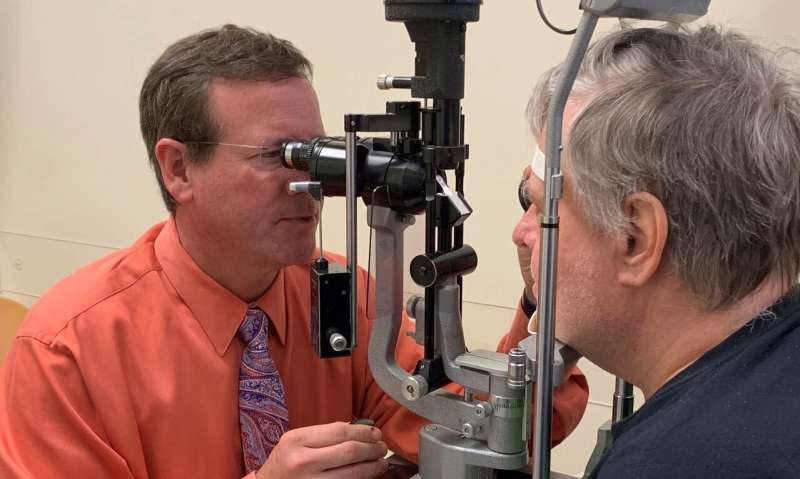Watchful waiting reasonable for patients with diabetic macular edema and good vision

People with good vision despite having center-involved diabetic macular edema can safely forego immediate treatment of their eye condition as long as they are closely monitored, and treatment begins promptly if vision worsens, according to clinical trial results. The findings are published online today in the Journal of the American Medical Association.
The study was conducted by the DRCR Retina Network a multicenter clinical research network funded by the National Eye Institute, part of the National Institutes of Health (NIH).
Diabetic macular edema is the most common cause of vision loss among people with diabetic eye disease in the United States. Diabetes can result in the development of leaky blood vessels in the retina—the light-sensing tissue at the back of eye. Diabetic macular edema is the result of fluid build-up in the central area of the retina, called the macula, which is important for sharp vision. Swelling of the macula can distort vision required for reading and driving.
The evidence from this study should help physicians and patients navigate a common conundrum in ophthalmology: Treating diabetic macular edema in people who still have good vision too soon may subject them to unnecessary costs and risks associated with treatment. Other patients who get treatment too late might risk losing vision permanently.
"We now know that in patients with good vision and diabetic macular edema, similar to those enrolled in this trial, it's an acceptable strategy to closely monitor patients, and initiate treatment only if their vision starts to show signs of decline," said the study's lead investigator Carl W. Baker, M.D., an ophthalmologist at Paducah (Kentucky) Retinal Center.
Controlling blood sugar in diabetic patients helps prevent diabetic eye disease. In addition, therapies that directly target diabetic macular edema—laser photocoagulation and injections of anti-vascular endothelial growth factor (anti-VEGF) agents—reduce or eliminate abnormal leakage from blood vessels.
The trial included 702 participants with diabetic macular edema and 20/25 vision or better, which is considered normal or near normal vision. At the start of the study, participants were randomly assigned to one of the following three management strategies for one of their eyes: 1) inject into the eye the anti-VEGF agent aflibercept (EYLEA®) as frequently as every four weeks, 2) perform laser photocoagulation, or 3) conduct observation of the participants.
During the two-year study, the detection of visual acuity loss prompted aflibercept injections to be given to the people in the laser or observation groups. Aflibercept injections were thus required among 25% of the laser group and 34% of the observation group. Eyes that started aflibercept injections in the laser and observation groups required a similar number of injections overall compared to the group initially assigned to aflibercept.
The researchers checked participants' visual acuity throughout the study at regular follow-up visits in retina specialty clinics. Researchers measured visual acuity in the laser and observation groups at eight and 16 weeks after study entry, and then every 16 weeks unless their visual acuity worsened.
After two years, the percentage of participants whose study eye met a prespecified threshold for visual acuity loss—one or more lines on an eye chart—did not differ among the groups: 16% of the aflibercept group, 17% of the laser group, and 19% in the observation group. The average visual acuity, which was 20/20 at baseline, remained 20/20 in all three groups at two years.
"Based on what we've seen in previous, longer-term studies of people with diabetic macular edema, the visual acuity outcomes observed at the end of this two-year study are likely to be maintained if patients continue regular follow-up and treatment as needed over subsequent years," said DRCR Retina Network Co-Chair, Jennifer K. Sun, M.D., M.P.H., Associate Professor of Ophthalmology, Joslin Diabetes Center, Harvard Medical School.
"Future technology may do a better job of identifying who might benefit from early treatment, before diabetic macular edema affects vision," said the director of the study's coordinating center, Adam R. Glassman, MS, Jaeb Center for Health Research in Tampa. "But for now, close monitoring of diabetic macular edema in patients with good vision is an appropriate initial strategy as long as they are closely followed and subsequently treated if vision worsens."
More information: Carl W. Baker et al, Effect of Initial Management With Aflibercept vs Laser Photocoagulation vs Observation on Vision Loss Among Patients With Diabetic Macular Edema Involving the Center of the Macula and Good Visual Acuity, JAMA (2019). DOI: 10.1001/jama.2019.5790


















